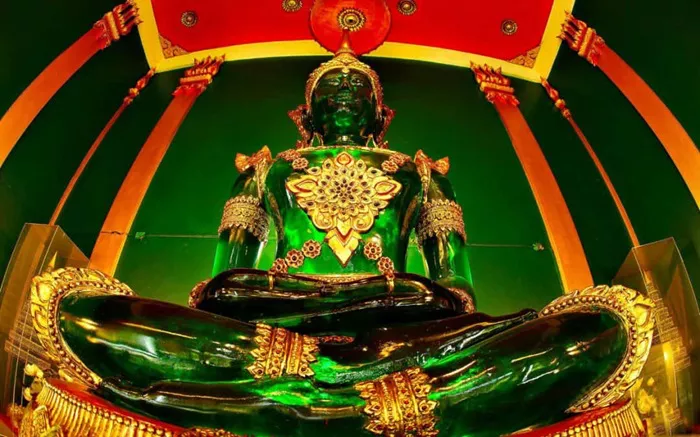The Emerald Buddha, also known as Phra Kaew Morakot in Thai, is one of the most revered Buddhist statues in the world. It is a symbol of Thailand’s spiritual and cultural identity, enshrined in the Wat Phra Kaew (Temple of the Emerald Buddha) within the Grand Palace complex in Bangkok. This article explores its history, physical attributes, religious significance, rituals, and its place in Thai society.
Historical Origins and Legends
Mythical Beginnings
Legends claim the Emerald Buddha was created in India around 500 BCE by the monk Phra Nak Sen, carved from a single block of green jade. Some stories even suggest it was crafted by divine beings and gifted to humans. One popular legend, the “Rattana Bimbang Sa,” narrates that celestial figures presented the statue to Phra Nak Sen, an arhat from the ancient Indian city of Pataliputra.
Documented History
The earliest verified historical record dates back to 1434 CE when lightning struck a stupa at Wat Pa Ya in Chiang Rai, revealing a stucco-covered and gilded Buddha image. Removing the plaster uncovered a magnificent green jade statue. This discovery marked the beginning of its journey across Southeast Asia. Over the centuries, the Emerald Buddha was moved to various locations, including Chiang Mai, Luang Prabang, Vientiane, and eventually Bangkok, where it found its permanent home in 1784 under King Rama I.
Royal Connections
The Emerald Buddha’s history is intertwined with Thai royal dynasties. King Mongkut (Rama IV) authored a historical account of the statue, while King Rama I established it as a symbol of national unity. The seasonal robe-changing ceremony, performed by the Thai king, further strengthens the link between the monarchy and Buddhism.
Physical Description
The Emerald Buddha is a seated meditation posture (samadhi) statue, measuring 66 centimeters (26 inches) tall and 48.03 centimeters (18.9 inches) wide. It is carved from a single block of dark green jadeite (not emerald), with intricate details such as a flame-like halo and delicate facial features. The statue’s posture, with hands in the earth-touching mudra (bhumisparsha mudra), symbolizes Buddha’s enlightenment under the Bodhi tree.
Religious Significance
National Palladium
The Emerald Buddha is considered Thailand’s palladium, believed to protect the nation from harm and ensure prosperity. It serves as a unifying symbol for Thai Buddhists, representing the country’s spiritual and cultural heritage.
Royal Authority
The annual robe-changing ceremony, performed by the Thai king, underscores the close relationship between the monarchy and Buddhism. This ritual, which dates back to the 18th century, is a testament to the Buddha’s role in Thai governance and society.
Spiritual Symbolism
For devotees, the Emerald Buddha embodies the Buddha’s teachings of compassion, wisdom, and enlightenment. Its presence in Wat Phra Kaew makes it a focal point for meditation and pilgrimage, attracting millions of visitors annually.
Rituals and Ceremonies
Seasonal Robe Changing
The most significant ritual is the changing of the Buddha’s robes three times a year, corresponding to Thailand’s seasons: summer, rainy, and winter. The king or a designated representative carefully removes the old robe, cleans the statue, and drapes it in a new, elaborately embroidered robe. The summer robe is lighter, the rainy-season robe is more protective, and the winter robe is warmer, symbolizing harmony with nature.
Public Participation
While the ceremony itself is a royal event, it holds deep meaning for the Thai people. It is broadcast nationwide, allowing citizens to witness the ritual and reflect on their spiritual practices. The robes, often adorned with gold and precious jewels, are displayed in the Grand Palace’s Pavilion of Regalia when not in use.
Related Buddha Statues
Reclining Buddha (Wat Pho)
Located near the Grand Palace, the Reclining Buddha is a 46-meter-long statue depicting Buddha’s final moments before entering nirvana. Its pose symbolizes the end of suffering and the attainment of enlightenment.
Laughing Buddha (Hotei)
The Laughing Buddha, a popular figure in Chinese Buddhism, is often confused with the historical Buddha. It represents happiness, prosperity, and contentment, with its rotund figure and smiling face.
Teaching Buddha
The Teaching Buddha statue, with its hands in the dharma wheel mudra (dharmachakra mudra), symbolizes the Buddha’s first sermon after enlightenment. This pose is common in temples across Asia.
Visiting the Emerald Buddha
Wat Phra Kaew
The Emerald Buddha is housed in the Ubosot (ordination hall) of Wat Phra Kaew, a temple known for its elaborate architecture and murals depicting scenes from the Ramakien, the Thai version of the Ramayana. Visitors must dress modestly and remove their shoes before entering.
Opening Hours and Etiquette
The temple is open daily from 8:30 AM to 3:30 PM. Photography inside the Ubosot is prohibited, and visitors should maintain silence and respect during their visit.
Conclusion
The Emerald Buddha is more than a religious icon; it is a cornerstone of Thai identity, blending spirituality, history, and art. Its journey across Southeast Asia, seasonal rituals, and royal connections highlight its enduring significance. Whether revered by devotees or admired by visitors, the Emerald Buddha continues to inspire awe and devotion, embodying the essence of Buddhism in Thailand.

